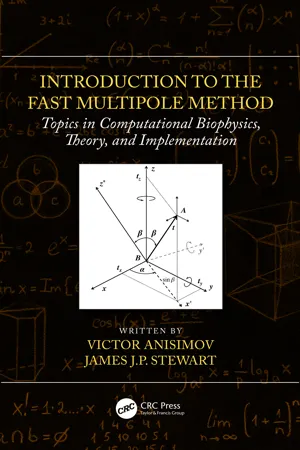
eBook - ePub
Introduction to the Fast Multipole Method
Topics in Computational Biophysics, Theory, and Implementation
This is a test
- 448 pages
- English
- ePUB (mobile friendly)
- Available on iOS & Android
eBook - ePub
Introduction to the Fast Multipole Method
Topics in Computational Biophysics, Theory, and Implementation
Book details
Book preview
Table of contents
Citations
About This Book
Introduction to the Fast Multipole Method introduces the reader to the theory and computer implementation of the Fast Multipole Method. It covers the topics of Laplace's equation, spherical harmonics, angular momentum, the Wigner matrix, the addition theorem for solid harmonics, and lattice sums for periodic boundary conditions, along with providing a complete, self-contained explanation of the math of the method, so that anyone having an undergraduate grasp of calculus should be able to follow the material presented. The authors derive the Fast Multipole Method from first principles and systematically construct the theory connecting all the parts.
Key Features
- Introduces each topic from first principles
- Derives every equation presented, and explains each step in its derivation
- Builds the necessary theory in order to understand, develop, and use the method
- Describes the conversion from theory to computer implementation
- Guides through code optimization and parallelization
Frequently asked questions
At the moment all of our mobile-responsive ePub books are available to download via the app. Most of our PDFs are also available to download and we're working on making the final remaining ones downloadable now. Learn more here.
Both plans give you full access to the library and all of Perlego’s features. The only differences are the price and subscription period: With the annual plan you’ll save around 30% compared to 12 months on the monthly plan.
We are an online textbook subscription service, where you can get access to an entire online library for less than the price of a single book per month. With over 1 million books across 1000+ topics, we’ve got you covered! Learn more here.
Look out for the read-aloud symbol on your next book to see if you can listen to it. The read-aloud tool reads text aloud for you, highlighting the text as it is being read. You can pause it, speed it up and slow it down. Learn more here.
Yes, you can access Introduction to the Fast Multipole Method by Victor Anisimov, James J.P. Stewart in PDF and/or ePUB format, as well as other popular books in Biological Sciences & Biology. We have over one million books available in our catalogue for you to explore.
Information
1
Legendre Polynomials
Electrostatics is a branch of physics that deals with determining the electrostatic potential created by a system of stationary or slowly moving electric charges. Elementary electrostatic theory for a system of point charges is rather straightforward. It consists of the Coulomb law and the superposition principle, summing over the independent pairwise interactions of individual particles. The Coulomb law describes the force, Fi, acting on particle i having charge qi arising from other particles having charge qj:
(1.1) |
|---|
where ri = (xi, yi, zi) represents a coordinate vector of particle i. Summation over the particles reflects the superposition principle according to which each pairwise interaction is essentially independent of the other ones.
Integration of Equation 1.1 leads to the definition of electrostatic potential, Φi:
(1.2) |
|---|
which, if multiplied by particle charge, qi, gives the electrostatic energy, Ui = qi Φi that particle i has in the presence of other charge sources j. Although, historically, the theory of electrosta...
Table of contents
- Cover
- Half Title
- Title Page
- Copyright Page
- Contents
- Preface
- 1. Legendre Polynomials
- 2. Associated Legendre Functions
- 3. Spherical Harmonics
- 4. Angular Momentum
- 5. Wigner Matrix
- 6. Clebsch–Gordan Coefficients
- 7. Recurrence Relations for Wigner Matrix
- 8. Solid Harmonics
- 9. Electrostatic Force
- 10. Scaling of Solid Harmonics
- 11. Scaling of Multipole Translations
- 12. Fast Multipole Method
- 13. Multipole Translations along the z-Axis
- 14. Rotation of Coordinate System
- 15. Rotation-Based Multipole Translations
- 16. Periodic Boundary Conditions
- Appendix
- Bibliography
- Index